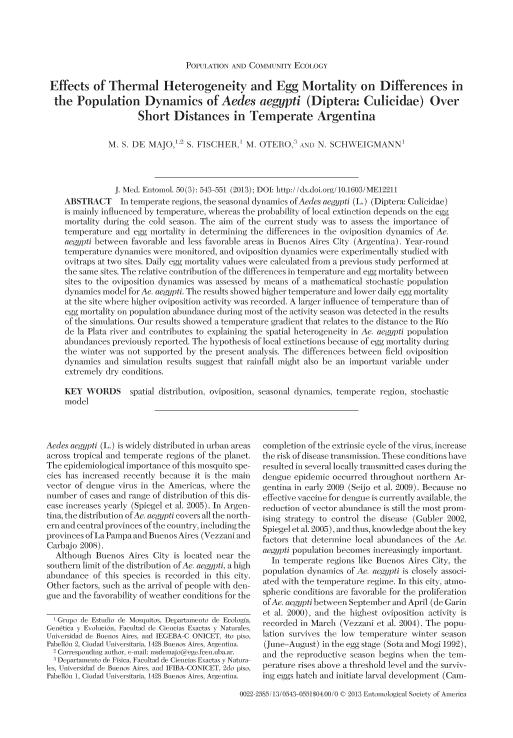Mostrar el registro sencillo del ítem
dc.contributor.author
de Majo, María Sol

dc.contributor.author
Fischer, Sylvia Cristina

dc.contributor.author
Otero, Marcelo Javier

dc.contributor.author
Schweigmann, Nicolas Joaquin

dc.date.available
2015-10-05T19:40:08Z
dc.date.issued
2013-05-01
dc.identifier.citation
de Majo, María Sol; Fischer, Sylvia Cristina; Otero, Marcelo Javier; Schweigmann, Nicolas Joaquin; Effects of Thermal Heterogeneity and Egg Mortality on Differences in the Population Dynamics of Aedes aegypti (Diptera: Culicidae) Over Short Distances in Temperate Argentina; Entomological Society of America; Journal of Medical Entomology; 50; 3; 1-5-2013; 543-551
dc.identifier.issn
0022-2585
dc.identifier.uri
http://hdl.handle.net/11336/2329
dc.description.abstract
In temperate regions, the seasonal dynamics of Aedes aegypti (L.) (Diptera: Culicidae) is mainly influenced by temperature, whereas the probability of local extinction depends on the egg mortality during the cold season. The aim of the current study was to assess the importance of temperature and egg mortality in determining the differences in the oviposition dynamics of Ae. aegypti between favorable and less favorable areas in Buenos Aires City (Argentina). Year-round temperature dynamics were monitored, and oviposition dynamics were experimentally studied with ovitraps at two sites. Daily egg mortality values were calculated from a previous study performed at the same sites. The relative contribution of the differences in temperature and egg mortality between sites to the oviposition dynamics was assessed by means of a mathematical stochastic population dynamics model for Ae. aegypti. The results showed higher temperature and lower daily egg mortality at the site where higher oviposition activity was recorded. A larger influence of temperature than of egg mortality on population abundance during most of the activity season was detected in the results of the simulations. Our results showed a temperature gradient that relates to the distance to the Río de la Plata river and contributes to explaining the spatial heterogeneity in Ae. aegypti population abundances previously reported. The hypothesis of local extinctions because of egg mortality during the winter was not supported by the present analysis. The differences between field oviposition dynamics and simulation results suggest that rainfall might also be an important variable under extremely dry conditions.
dc.format
application/pdf
dc.language.iso
eng
dc.publisher
Entomological Society of America

dc.rights
info:eu-repo/semantics/openAccess
dc.rights.uri
https://creativecommons.org/licenses/by/2.5/ar/
dc.subject
OVIPOSITION
dc.subject
SEASONAL DYNAMICS
dc.subject
SPATIAL DISTRIBUTION
dc.subject
STOCHASTIC MODEL
dc.subject
TEMPERATE REGION
dc.subject.classification
Zoología, Ornitología, Entomología, Etología

dc.subject.classification
Ciencias Biológicas

dc.subject.classification
CIENCIAS NATURALES Y EXACTAS

dc.subject.classification
Ecología

dc.subject.classification
Ciencias Biológicas

dc.subject.classification
CIENCIAS NATURALES Y EXACTAS

dc.title
Effects of Thermal Heterogeneity and Egg Mortality on Differences in the Population Dynamics of Aedes aegypti (Diptera: Culicidae) Over Short Distances in Temperate Argentina
dc.type
info:eu-repo/semantics/article
dc.type
info:ar-repo/semantics/artículo
dc.type
info:eu-repo/semantics/publishedVersion
dc.date.updated
2016-03-30 10:35:44.97925-03
dc.journal.volume
50
dc.journal.number
3
dc.journal.pagination
543-551
dc.journal.pais
Estados Unidos

dc.journal.ciudad
Annapolis
dc.conicet.avisoEditorial
This article is the copyright property of the Entomological Society of America and may not be used for any commercial or other private purpose without specific written permission of the Entomological Society of America
dc.description.fil
Fil: de Majo, María Sol. Universidad de Buenos Aires. Facultad de Ciencias Exactas y Naturales. Departamento de Ecología, Genética y Evolución. Grupo de Estudio de Mosquitos; Argentina. Consejo Nacional de Investigaciones Científicas y Técnicas. Oficina de Coordinación Administrativa Ciudad Universitaria. Instituto de Ecología, Genética y Evolución de Buenos Aires; Argentina
dc.description.fil
Fil: Fischer, Sylvia Cristina. Consejo Nacional de Investigaciones Científicas y Técnicas. Oficina de Coordinación Administrativa Ciudad Universitaria. Instituto de Ecología, Genética y Evolución de Buenos Aires; Argentina. Universidad de Buenos Aires. Facultad de Ciencias Exactas y Naturales. Departamento de Ecología, Genética y Evolución. Grupo de Estudio de Mosquitos; Argentina
dc.description.fil
Fil: Otero, Marcelo Javier. Consejo Nacional de Investigaciones Científicas y Técnicas. Oficina de Coordinación Administrativa Ciudad Universitaria. Instituto de Física de Buenos Aires; Argentina. Universidad de Buenos Aires. Facultad de Ciencias Exactas y Naturales. Departamento de Física; Argentina
dc.description.fil
Fil: Schweigmann, Nicolas Joaquin. Consejo Nacional de Investigaciones Científicas y Técnicas. Oficina de Coordinación Administrativa Ciudad Universitaria. Instituto de Ecología, Genética y Evolución de Buenos Aires; Argentina. Universidad de Buenos Aires. Facultad de Ciencias Exactas y Naturales. Departamento de Ecología, Genética y Evolución. Grupo de Estudio de Mosquitos; Argentina
dc.journal.title
Journal of Medical Entomology

dc.relation.alternativeid
info:eu-repo/semantics/altIdentifier/doi/http://dx.doi.org/10.1603/ME12211
dc.relation.alternativeid
info:eu-repo/semantics/altIdentifier/url/http://jme.oxfordjournals.org/content/50/3/543
dc.relation.alternativeid
info:eu-repo/semantics/altIdentifier/url/http://www.bioone.org/doi/abs/10.1603/ME12211
Archivos asociados
